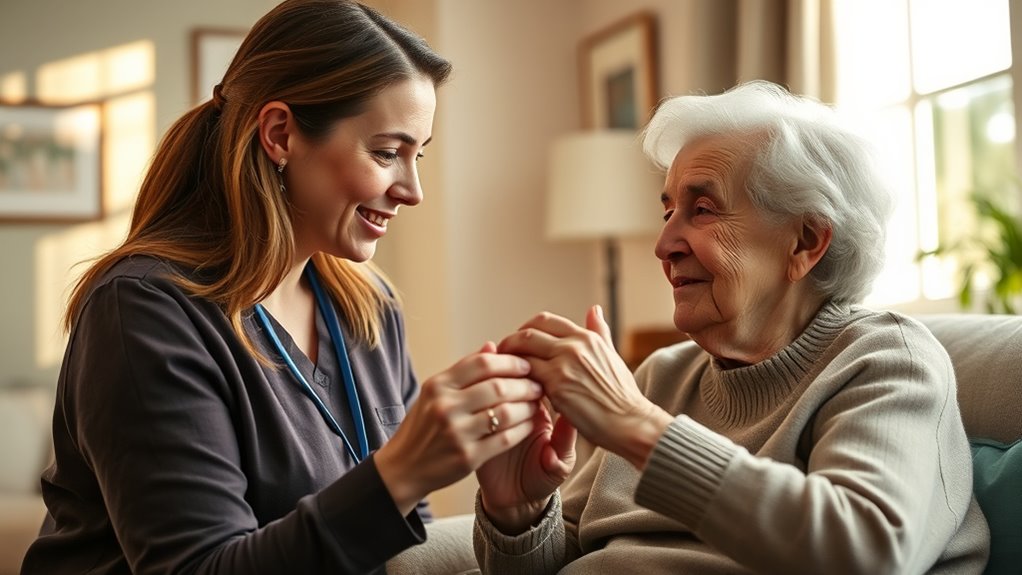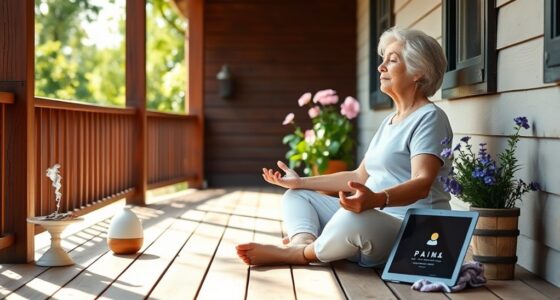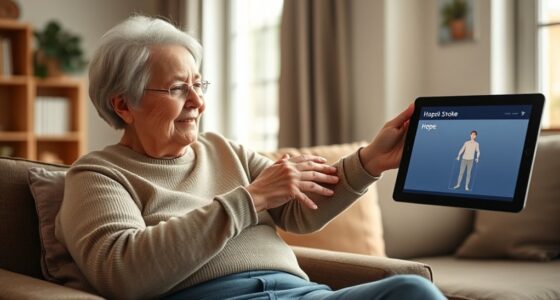To teach self-soothing skills to dementia patients, focus on creating a calm environment with familiar objects, gentle lighting, and low noise. Observe what activities or stimuli help them relax, such as music or tactile toys, and introduce routines that provide predictability. Use soothing tones and encourage participation at their comfort level. The key is to tailor approaches and be patient—learning more about personalized techniques can make a meaningful difference in easing agitation.
Key Takeaways
- Observe individual preferences to identify effective calming activities, such as music, tactile objects, or scents.
- Create a calm, familiar environment with soothing lighting, low noise, and familiar objects to promote relaxation.
- Establish simple, consistent routines and visual cues to help dementia patients recognize and anticipate self-soothing activities.
- Use gentle guidance and positive reinforcement to encourage participation without pressure or confusion.
- Involve caregivers to ensure consistency across settings and gradually extend the duration of self-soothing practices.
Understanding the Needs of Dementia Patients

Understanding the needs of dementia patients is essential for providing effective care. You must recognize that their behaviors often stem from confusion, fear, or frustration. As their cognitive abilities decline, they may struggle to communicate their feelings clearly, so paying close attention to non-verbal cues becomes crucial. You should also consider that their sense of safety and familiarity influences their emotional state. Providing routines and a calm environment helps reduce anxiety. Additionally, understanding that their needs may change day to day helps you adapt your approach. Patience and empathy are key, as they require reassurance and support without judgment. By truly understanding what drives their behaviors, you can better tailor your responses and foster a sense of security.
Identifying Effective Self-Soothing Techniques
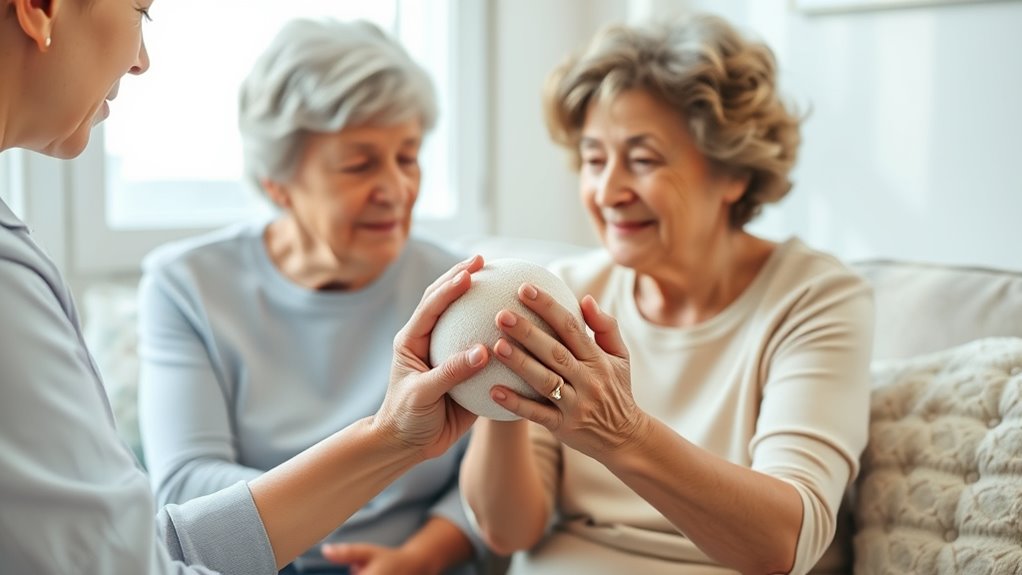
Finding effective self-soothing techniques is essential for helping dementia patients manage anxiety and agitation. You should observe their responses to different activities to identify what brings comfort. Some patients find relief through tactile stimuli like soft fabrics or fidget toys, while others respond well to gentle music or familiar scents. Pay attention to their facial expressions, body language, and verbal cues to determine which methods seem to calm them. Keep in mind that effectiveness can vary from person to person and may change over time. Carefully documenting these responses helps you tailor approaches to each individual. Additionally, understanding the role of sensory input in calming techniques can enhance your ability to select appropriate activities. Incorporating personalized interventions based on individual preferences ensures more effective soothing. Recognizing the importance of behavioral cues can further refine your approach to calming strategies. By actively identifying what soothes your patient, you empower yourself to implement personalized strategies that reduce distress and promote a sense of safety.
Creating a Calm and Supportive Environment
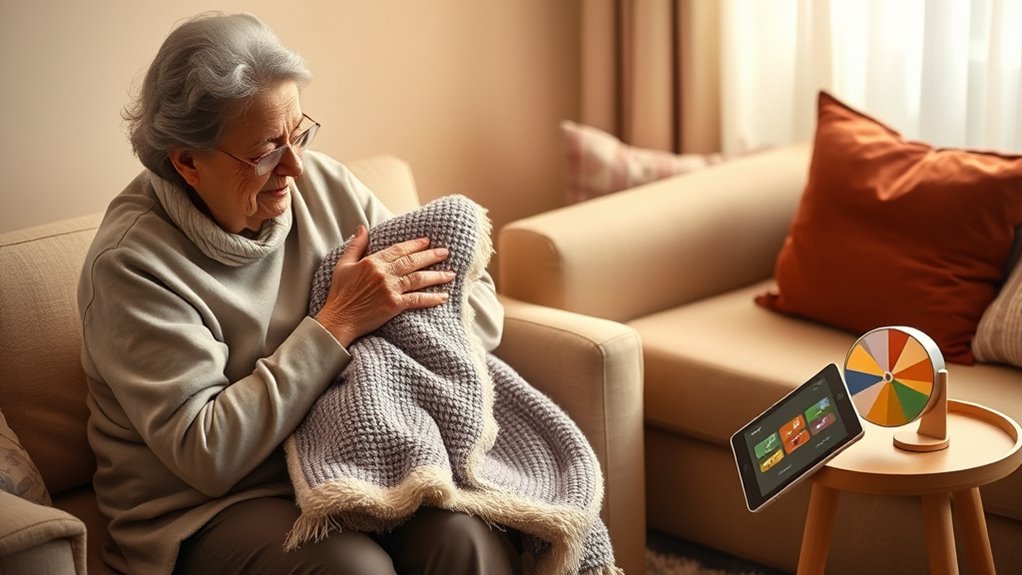
Once you’ve identified which self-soothing techniques work best for your dementia patients, creating a calm and supportive environment becomes the next step. Your goal is to reduce stress and promote comfort through a peaceful space. You can achieve this by:
Creating a calm environment with soothing lighting, low noise, and familiar objects helps dementia patients feel safe and relaxed.
- Using soft, natural lighting to avoid harsh shadows and glare
- Keeping noise levels low to prevent overstimulation
- Arranging furniture to create clear, unobstructed pathways for safety
- Incorporating familiar objects or photos to evoke a sense of familiarity and security
Engaging Patients in Relaxation Activities
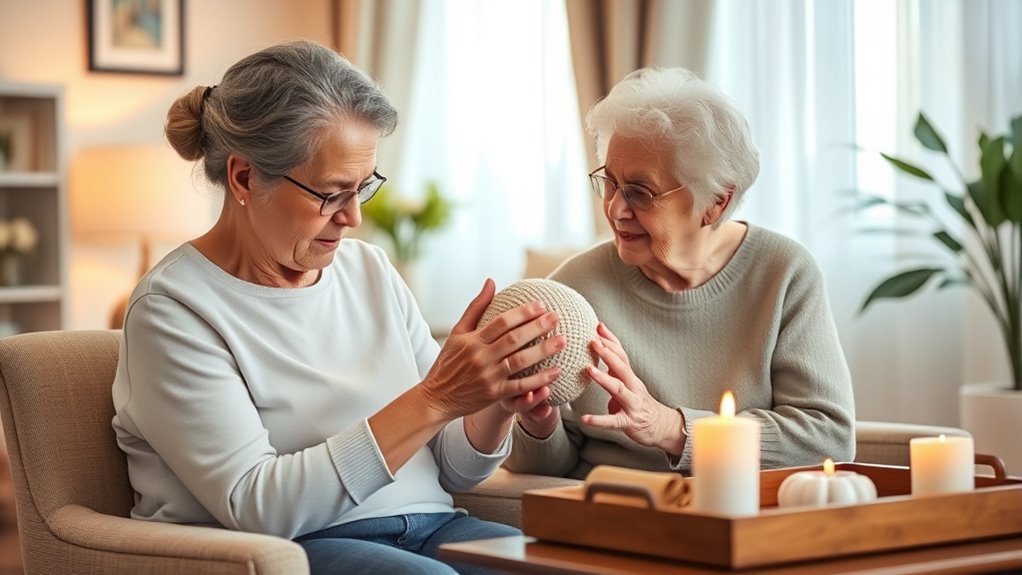
Engaging patients in relaxation activities helps them experience moments of calm and reduce agitation. You can start by observing what activities soothe them, like listening to gentle music, holding a soft object, or practicing simple breathing exercises. Offer these options consistently, creating a routine that signals safety and familiarity. Use a calm, gentle tone to guide them through each activity, encouraging participation without pressure. Incorporate sensory stimuli, such as aromatherapy or tactile objects, to enhance relaxation. Pay attention to their responses, adjusting activities based on what seems most effective. Remember, the goal is to foster a sense of comfort and control, so keep activities simple, brief, and positive. Your patience and attentiveness help make relaxation a calming, enjoyable experience. Additionally, understanding the financial impact of entertainment industries can help caregivers appreciate the value of engaging activities that stimulate emotional well-being, and exploring crochet styles for locs can inspire creative ways to incorporate tactile and visual stimulation into daily routines. Incorporating mindfulness techniques into routines can further help in promoting relaxation and emotional stability. Recognizing the importance of specialized hair care products, such as gentle shampoos and oils, can also support overall well-being by maintaining comfort and dignity during grooming routines.
Supporting Consistency and Progress in Self-Soothing Practices
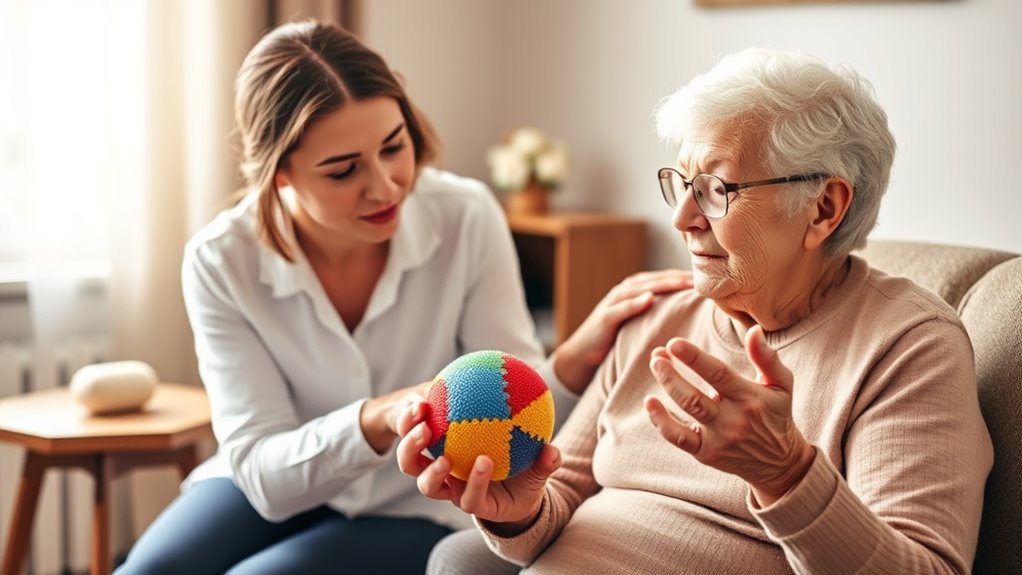
Supporting consistency and progress in self-soothing practices requires you to establish routines that patients can reliably follow, helping them recognize and anticipate calming activities. Consistent routines create a sense of security and familiarity, making self-soothing easier over time. To reinforce progress, track each patient’s responses and adjust activities as needed. Reinforce success with gentle encouragement and positive reinforcement. You can also:
Establish reliable routines to foster security and support progress in self-soothing practices.
- Use visual cues or reminders to signal calming activities
- Keep routines simple and predictable to reduce confusion
- Gradually increase the duration of self-soothing sessions
- Involve caregivers to ensure consistency across settings
Frequently Asked Questions
How Can Family Members Best Support Self-Soothing Efforts at Home?
You can best support self-soothing efforts at home by creating a calm, familiar environment. Use gentle tones, soft lighting, and comforting objects to reduce stress. Encourage routines that provide structure and predictability. Be patient and attentive, offering reassurance without forcing actions. Show empathy, listen actively, and respect their cues. Your consistent presence and understanding help them feel safe, making self-soothing easier and more effective.
Are There Specific Medications That Enhance Self-Soothing in Dementia Patients?
You might wonder if specific medications can help dementia patients self-soothe. While some medications, like antianxiety drugs or antidepressants, may reduce agitation, they aren’t directly designed to enhance self-soothing. Always consult a healthcare professional before considering medication options. They can assess whether medication, combined with behavioral strategies, best supports your loved one’s comfort and emotional stability. Remember, medication should complement, not replace, personalized care approaches.
How Do Cultural Differences Influence Self-Soothing Preferences?
You should consider how cultural differences shape self-soothing preferences, as they influence comfort objects, communication styles, and calming activities. For example, some cultures favor physical touch or prayer, while others prefer quiet reflection or music. By understanding these cultural nuances, you can tailor self-soothing techniques to better meet each patient’s needs, making them feel more secure and respected, and ultimately improving their overall well-being.
What Signs Indicate a Need to Modify Self-Soothing Strategies?
When you see signs like increased agitation, withdrawal, or repeated behaviors, it’s time to switch up your self-soothing strategies. If a patient seems more distressed despite your efforts, don’t beat around the bush—try different techniques or environments. Sometimes what worked before no longer does, so stay flexible. Listening carefully to their cues helps you adapt, ensuring they feel safe and comforted instead of overwhelmed.
How Can Technology Assist in Teaching Self-Soothing Skills?
Technology can be a powerful tool in teaching self-soothing skills by providing interactive and personalized experiences. You can use apps or devices that offer calming sounds, guided meditations, or visual stimuli tailored to individual preferences. These tools enable you to track progress and adjust strategies as needed. By integrating technology, you make learning self-soothing techniques engaging and accessible, helping dementia patients develop calming routines more effectively.
Conclusion
By building bonds, boosting comfort, and cultivating calm, you empower dementia patients to develop self-soothing skills. Consistent caring creates a comforting, calming cycle, fostering familiarity and confidence. Remember, patience and persistence pave the path to peace, progress, and positive progress. With compassion and commitment, you can help patients find their tranquility, transforming turbulence into tenderness. Your dedication makes a difference, delivering dignity, comfort, and calming continuity every step of the way.
